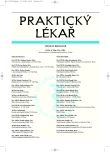Treatment of tobacco dependence: prevention, diagnosis and treatment in General Practice
Authors:
E. Králíková 1,2; S. Býma 3; S. Konštacký 3
Authors‘ workplace:
Univerzita Karlova v Praze, 1. LF a VFN, Ústav hygieny a epidemiologie
Přednosta: prof. MUDr. Vladimír Bencko, DrSc.
1; Centrum léčby závislosti na tabáku III. interní kliniky 1. LF UK a VFN, Praha
Přednosta: prof. MUDr. Štěpán Svačina, DrSc., MBA
2; Ústav sociálního lékařství LF UK, Hradec Králové
Přednosta: prof. PhDr. Jiří Mareš, CSc.
3
Published in:
Prakt. Lék. 2008; 88(5): 258-261
Category:
Reviews
Overview
Tobacco dependence is the most important preventable cause of morbidity and mortality. Among Czech smokers, about 70 % (1.75 million) would prefer not to smoke; and about 40 % (about 1 million) try to stop each year. Since the majority attempt to quit unaided without medical assistance, the success rate is only about 3%. Effective treatment exists: with intensive intervention and pharmacotherapy the abstinence rates could reach over 30 %. Treatment of tobacco dependence should be offered to all smokers by all physicians, namely by general practitioners. Even if there are time limitations, a short intervention should be offered at the very least. Both Czech and international guidelines for the treatment of tobacco dependence for general practitioners are now available.
Key words:
tobacco dependence treatment, general practitioner.
Sources
1. American Psychiatric Association. Nicotine-induced disorder. Diagnostic and Statistical Manual of Mental Disorders (DSM-IV), Washington, 994, p. 244-247.
2. Býma, S., Hradec, J., Herber, O., Karen, I. Prevence kardiovaskulárních onemocnění, Doporučený diagnostický a léčebný postup pro všeobecné praktické lékaře. Společnost všeobecného lékařství ČLS JEP, 2004; ISBN 80-903573-5-0. Dostupné na www.svl.cz
3. Cahill, K., Stead, L., Lancaster, T. Nicotine receptor partial agonists for smoking cessation. Cochrane Library (issue 1). Dostupné na http://www.mrw.interscience. wiley.com/cochrane/ clsysrevarticles/CD006103/frame.html
4. Čupka, J., Nešpor, K., Králíková, E. a kol. Léčba závislosti na tabáku v ordinaci praktického lékaře. Doporučený diagnostický a léčebný postup pro všeobecné praktické lékaře. Centrum doporučených postupů pro praktické lékaře, nadační fond Praktik, Praha, 2006, 9 s.
5. Fiore, M. C., Bailey, W. C., Cohen, S. J., et al. Treating Tobacco Use and Dependence. Clinical Practice Guideline. Rockville, MD: U.S. Department of Health and Human Services. Public Health Service. June 2000. Dostupné na www.surgeongeneral.gov/tobacco
6. Gonzales, D., Rennard, S. I., Nides, M. et al. Varenicline, an alpha4beta2 nicotinic acetylcholine receptor partial agonist, vs sustained-release bupropion and placebo for smoking cessation: a randomized controlled trial. JAMA 2006, 296, 1, p. 47-55.
7. Heatheron, T. F., Kozlowski, L., T., Frecker, R. C., Fagerström, K. O. The fagerström test of nicotine dependence: a revision of the Fagerström Tolerance Questionnaire. Brit. J. Addiction, 86, 1991, p. 1119-1127.
8. Hughes, J., Stead, L. F., Lancaster, T. Antidepressants for smoking cessation, Cochrane Database for Systematic reviews, 2006, issue 4. Dostupné na http://www3.interscience.wiley.com/ cgi-bin/mrwhome/106568753/HOME
9. International Primary Care Respiratory Group. Tackling the Smoking Epidemy. IPCRG international guidance on smoking cessation in primary care. Dostupné na http://www.theipcrg.org/ smoking/index.php
10. Jorenby, D. E., Hays, J. T., Rigotti, N. A. et al. Varenicline Phase 3 Study Group. Efficacy of varenicline, an alpha4beta2 nicotinic acetylcholine receptor partial agonist, vs placebo or sustained-release bupropion for smoking cessation: a randomized controlled trial, JAMA, 2006, 296, 1, p. 56-63.
11. Miovský, M., Miovská, L. Aktuální situace v užívání návykových látek v ČR a založení nového oboru adiktologie, Prakt. lék., 86, 2006, 3, s. 138-143.
12. Peto, R., Lopez, A. D., Boreham, J. et al. Mortality From Smoking in Developed Countries 1950 - 2000. Oxford, UK: Oxford University Press, 1994, update 2006. Dostupné též na http://www.deathsfromsmoking.net
13. Králíková, E. Prevence závislosti na tabáku. Česko-slovenská pediatrie, 61, 2006, 3, s. 149-154.
14. Králíková, E., Býma, S., Cífková, R. et al. Doporučení pro léčbu závislosti na tabáku. Čas. lék. čes. 144, 2005, 5, s. 327-333.
15. Raw, M., McNeill, A., West, R. Smoking cessation: evidence based recommendations for the healthcare system. BMJ 1999, 318 (7177), p. 182-185.
16. Tonstad, S., Tonnesen, P., Hajek, P. et al. Varenicline Phase 3 Study Group: Effect of maintenance therapy with varenicline on smoking cessation: a randomized controlled trial, JAMA, 2006, 296, 1, p. 64-71.
17. Varenicline. Guidance for health professional on a new prescription-only stop smoking medication. London: ASH, November 2006. Dostupné na http://www.ash.org.uk/files/documents/ASH_447.pdf
18. West, R., McNeill, A., Raw, M. Smoking cessation guidelines for health professionals: an update. Thorax, 2000, 55, p. 987-999.
19. World Health Organization. International Statistical Classification of Diseases and Related Health Problems, 10th Revision. Geneva: World Health Organization, 1992.
20. Býma, S., Herbert, O. Projekt Atlet. Dostupné na http://www.atlet.cz/img/Atlet/atlet_vysledky.ppt.
Labels
General practitioner for children and adolescents General practitioner for adultsArticle was published in
General Practitioner

2008 Issue 5
- Metamizole vs. Tramadol in Postoperative Analgesia
- Metamizole at a Glance and in Practice – Effective Non-Opioid Analgesic for All Ages
- Memantine in Dementia Therapy – Current Findings and Possible Future Applications
- Hope Awakens with Early Diagnosis of Parkinson's Disease Based on Skin Odor
- Possibilities of Using Metamizole in the Treatment of Acute Primary Headaches
Most read in this issue
- The late effects of xenobiotics. 1. effect mechanisms and their occurrence in the environment
- History, present problems and challenges in prevention of nosocomial infections
- Violence as a disquieting phenomenon in contemporary health services
- Treatment of tobacco dependence: prevention, diagnosis and treatment in General Practice
